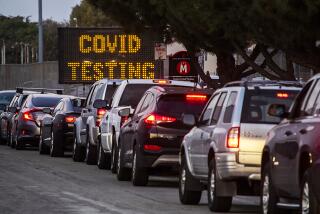Op-Ed: Time to prepare for an even more deadly pandemic
- Share via
The winner of the presidential election, whether that is Donald Trump or Joe Biden, will need to overcome the COVID-19 pandemic — the worst international health emergency since the 1918 influenza outbreak — and also begin preparing the United States and the world for the next pandemic.
Think it is too soon to worry about another pandemic? World leaders have called the coronavirus outbreak a “once-in-100-year” crisis, but there is no reason to expect that to be true. A new outbreak could easily evolve into the next epidemic or a pandemic that spreads worldwide. As lethal as this coronavirus has been, a novel influenza could be worse, transmitting even more easily and killing millions more people.
Better preparation must begin with an unvarnished assessment of what has gone wrong in the U.S. and in the global response to the current pandemic and what can be done to prepare for the next one when it strikes, as it inevitably will.
Preparedness needs to start with investment. Despite multiple recent threats, from SARS (2003) to H5N1 (2007) to H1N1 (2009) to Ebola (2013-2016); many blue ribbon reports and numerous national intelligence assessments; international assistance for pandemic preparedness has never amounted to more than 1% of overall international aid for health.
The United States devoted an even smaller share of its foreign aid budget in 2019 — $374 million out of $39.2 billion — to prepare for a pandemic that has now cost the country trillions of dollars. Meanwhile, funding for the Centers for Disease Control and Prevention’s support to states and territories has fallen by more than a quarter since 2002. Over the last decade, local public health departments have cut 56,360 staff positions because of lack of resources.
Preparation isn’t only about investing more money. It is also about embracing the public health fundamentals that allowed some nations to move rapidly and aggressively against the coronavirus. The United States has been hard hit by this pandemic, but all countries were dealt this hand.
But we can do better. Here are four measures, outlined in a new report from the Council on Foreign Relations, that would make Americans and the rest of the world safer.
First, the United States must remain a member of the World Health Organization, while working to reform it from within. The agency is hardly perfect, but it prompted China to notify the world of the coronavirus and it has coordinated the better-than-expected response to the pandemic in developing nations. Yet, the agency has no authority to make member states comply with their obligations and less than half of the annual budget of New York-Presbyterian Hospital. The WHO needs more dedicated funding for its Health Emergencies Program and should be required to report when governments fail to live up to their treaty commitments.
Second, we need a new global surveillance system to identify pandemic threats, one that is less reliant on self-reporting by early affected nations. An international sentinel surveillance network, founded on healthcare facilities rather than governments, could regularly share hospitalization data, using anonymized patient information. Public health agencies in nations participating in this network, including the CDC, can assess that data, identify unusual trends and more quickly respond to emerging health threats.
The U.S. should take the lead in forming a coalition to work alongside the WHO to develop this surveillance network. We should also work with like-minded G-20 partners, as well as private organizations, in this coalition to reduce unnecessary trade and border restrictions; increase the sharing of vaccines, therapeutics and diagnostics; and work with international financial institutions to provide foreign aid and debt relief packages to hard-hit nations.
Third, responding to a deadly contagion requires a coordinated national approach. Too often in this pandemic, in the absence of federal leadership, states and cities competed for test kits and scarce medical supplies and adopted divergent policies on reopening their economies. The next administration needs to clarify the responsibilities of the federal government, states and 2,634 local and tribal public health departments in pandemic preparedness and response. Elected leaders, starting with the president, must also put public health officials at the forefront of communicating science-based guidance and defend those officials from political attacks.
Finally, the U.S. must do better by its most exposed and vulnerable citizens. More than 35% of deaths in the U.S. from COVID-19 have been nursing home residents. Many others have been essential workers, who are disproportionately Black and Latinx and from low-income communities. Federal, state and local governments should direct public health investments to these groups as a matter of social justice and preparedness for future threats.
All of this will require leadership and marshaling support at home and abroad. The next president need not be doomed to replay this current catastrophe — provided he acts on the tragic lessons learned from the COVID-19 pandemic.
Thomas J. Bollyky is director of the global health program and Stewart M. Patrick is director of the global governance program at the Council on Foreign Relations. They are co-directors of the bipartisan CFR-sponsored Independent Task Force on Preparing for the Next Pandemic.
More to Read
A cure for the common opinion
Get thought-provoking perspectives with our weekly newsletter.
You may occasionally receive promotional content from the Los Angeles Times.










